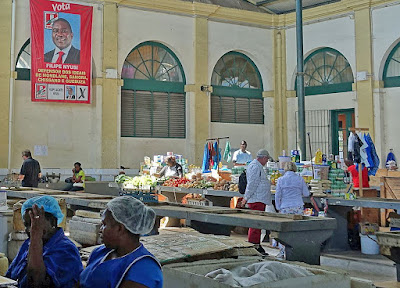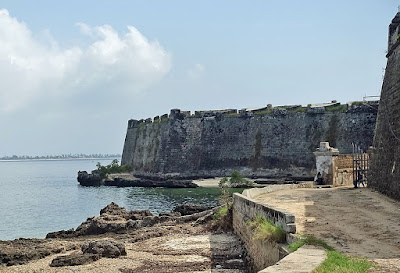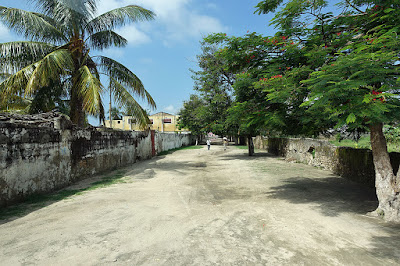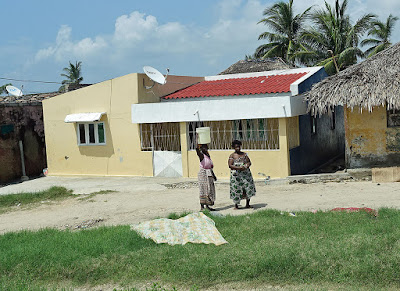Day 9: Maputo, Mozambique
Maputo is the capital, and largest city in Mozambique, with a population of about 1 million. Our shore excursion was a bus tour of the city. There was some interesting architecture, including the railroad station and city market. What struck me was that from a distance many of the buildings looked modern, but when viewed up close, they were falling apart.
Up until this point, the weather had been fairly mild, with highs in the low 80's and not too much humidity. Starting in Maputo it got pretty uncomfortable, with highs near 90 and very humid.
 |
| Downtown Maputo, viewed from the ship |
 |
| Plaza and buildings across from the railway station |
 |
| The port area, with our ship in the background |
The souvenir salesmen (they were all men) in Maputo were unusually aggressive--every time we got off the bus, we were mobbed.
After the railway station, we made a stop at the central market, in another building that was constructed in the early 1900's.
 |
| Entrance to the market |
From the market, we traveled to the Maputo Fortress, a fort that was built by the Portuguese in 1781.
 |
| Central Maputo, on the way to the fort |
 |
| Some new construction, viewed from the fort grounds |
 |
| Inside the fort |
 |
| A boulevard in central Maputo |
 |
| What I said about buildings not looking so good close up |
Our next stop was
Independence Square, which featured a statue of Samora Machel (first president of Mozambique), Maputo City Hall, and the Cathedral of Our Lady of the Immaculate Conception
 |
| Independence Square |
 |
| Maputo City Hall |
 |
| Cathedral of Our Lady of Immaculate Conception |
 |
| Looking down Avenida Samora Machel |
Across from Independence Square is "Iron House" which was designed by Gustave Eiffel for the colonial governor of Mozambique. The house is made entirely of iron, constructed in France and shipped to Maputo. The governor lived in it one day before moving out because it was too hot.
 |
| Iron House |
 |
| At Iron House--the walls are iron |
 |
| A view from Iron House |
From Independence Square, we went to the Museum of Natural History.
 |
| Outside the museum |
 |
| Inside the museum |
From the museum, we traveled through a relatively nice area to the craft market.
 |
| An apartment building |
 |
| In the streets |
 |
| At the craft market |
 |
| More items at the craft market |
After visiting the craft market, we headed back to the ship.
 |
| A modern mall in some disrepair |
 |
| Back on the ship |
Day 10: Mozambique Island
As I mentioned in the introduction, we were originally scheduled to stop in Madagascar, but for some reason the cruise line felt that it was unwise to stop there during a bubonic plague outbreak. So, instead we stopped at Mozambique Island, which gets very limited tourism, and I think I know why. Mozambique Island is a close contender with the Gambia for the title of "Most Depressing Cruise Port". Although part of the island has been designated a UNESCO World Heritage Site, there has been almost no money invested to preserve or restore the historical sites. To add to that, there is almost no commerce on the island.
The island is divided into two parts: (1) Stone Town, which contains the historical buildings, and (2) Macuti, the residential area, which consists mostly of thatched-roof houses.
 |
| Entering Stone Town from the pier |
 |
| A beach next to the pier |
One of the few buildings in decent shape is the Palace and Chapel of Sao Paulo, which was built in 1610, and is now used as a museum.
 |
| The museum with a statue of Vasco de Gama. |
 |
| Some locals meeting us on arrival |
In front of the museum, there were a few souvenir stalls set up. That was pretty much it for shopping.
In front of the museum we got on a bus for a tour of the island. It was literally the only bus on the island.
Stone Town was originally established as a Portuguese trading post. Almost all of the buildings in Stone Town are empty, awaiting renovation. Below are a few shots.
 |
| Municipal soccer field |
At one end of the island was the Portuguese fort of Sao Sebastao, which was built in the 16th century.
From the fort, we went back through Stone Town to the residential part of the island.
Along the way, we stopped at a Hindu temple, where we received a lecture about the temple from a resident who spoke almost no English.
 |
| At the Hindu Temple |
 |
| Inside the temple |
 |
| No comment |
From the temple, we continued on to Macuti. The following shots are all from Macuti.
The locals were very excited to see us. I imagine they don't get many tourists visiting.
 |
| Jacob's Bar |
 |
| One-lane bridge to the mainland |
Heading back to the pier, we passed an area that housed the fishing fleet, such as it was.
 |
| The Fish Market |
 |
| A local school |
Along the way, we stopped at a memorial at the site where slaves were held.
 |
| Exterior of the slavery memorial |
 |
| Our guide at the memorial |
 |
| Where the slaves where held |
 |
| Road construction |
Eventually, we returned to the pier, and bought a few souvenirs.
 |
| At the post office |
 |
| Next to the pier, with the fort in the far background |
 |
| Heading back to the ship |
Next:
Days 11-13 -- Mayotte and Zanzibar























































































